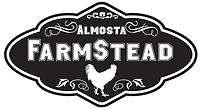






Almosta Farmstead
Livestock Guardians (LGDs)
We adore puppies...BUT...Are you ready for an LGD?
We are exceptionally pleased with the combined characteristics of the Akbash, Great Pyrenees, and Anatolian Shepherd in body structure, temperament, and health.
Here are some guidelines for taking care of your guardian:
-
When you take your puppy home, supervise his play so he does not become over tired, - he is still a baby!
-
Do not let him jump down steps or out of a vehicle - this strains his shoulders and front assembly.
-
Keep him secured in a suitable cage while traveling.
-
Don’t let him run and slide on a slippery indoor surface on which he can't gain traction.
-
No unsupervised playing with adult dogs - be sure you are right there beside him. This also applies to puppies playing with children.
-
Avoid long tiring walks on a leash. A very short walk will suffice for lead training and accustom him to walking by your side and not pulling out in front.
-
Do prevent too rapid growth by not over feeding him. He should look slim and trim!
-
Do not be afraid to “make a pet of” your livestock guardian dog. We find that, although all of our dogs would love to spend an evening on the living room rug ‘watching TV’, they are always glad to be back out in the pastures running the fence lines and protecting their animal family. Socialization makes them safer around visitors, and much easier to handle when Vet care is required.
Livestock Guardians have a strong sense of ownership; ownership of property - everything living on the property and the people that live and frequent there. Ours will chase hawks, wild birds and ground squirrels, but don’t bother the chickens. They chase off wild critters, but sleep with the goats and birds. They bark at anyone new and take time to cautiously warm up to those who we appear to welcome on to our property as guests.
Livestock Guardians are large, and require a lot of exercise as well as sleep. They generally sleep most of the day and are quite active at night. Ours enjoy spending time resting with the animals, in the house and in the yard during the day and then they patrol most nights.
We breed unregistered Livestock Guardians (Akbash/Great Pyrenees/Anatolian Shepherds) focusing on temperament, guarding behavior, and physical breed standards. Our puppies are raised along side of chickens and other poultry, playing with goat kids and baby animals as soon as they (the pups) can walk.
Although we have sold several puppies as pets, they are magnificent working dogs that thrive in the working environment. In fact, if you are considering a Livestock Guardian for a pet take a moment to look at the Pyrenees Rescues in your area. Many rescued guardians are incredibly loving dogs that just need a chance to become part of your family. The biggest concern good breeders have is ensuring that their puppies find good forever homes and are not used to reproduce puppies that will be unwanted and unloved.
If you are looking for a guardian animal for livestock and/or poultry that will also become a part of your family, a well bred LGD may be the perfect match. Rescued livestock guardians are usually not used as livestock dogs since there is no way of knowing how the dog was socialized to animals as a pup and so how it will react to your valuable livestock.
These are large dogs that require attention to their coat on a regular basis, especially if you will be bringing them inside on occasion as we do.
They require some escape from the heat of summer including shade and possibly a pool of water, but LOVE the winter months especially when it brings snow.
As breeds, the Great Pyrenees, Anatolian Shepherd, and Akbash are considered to be healthy breeds, relatively free of many of the problems that affect some other breeds. But, of course, there are problems which can appear in even the most carefully bred puppies. These are large dogs, considered one of the giant breeds, and can be susceptible to bone and joint problems.
Hip Dysplasia
This serious degenerative joint disease is most common in large and giant breeds of dogs like the Great Pyrenees, but it can also affect medium-sized breeds and even small breeds.
According to my research, most dogs who eventually develop hip dysplasia are often born with normal hips. As they grow and develop the ligaments fail, or are unable to hold the joint in place correctly and the bone of the hip begin rubbing against each other causing pain and eventually damage.
It is possible that excess weight the dog gains, especially during the fast growth period from three to ten months, puts too much stress on the joints. Obesity is always bad for Livestock Guardians, but is especially damaging to one who is genetically predisposed to hip dysplasia.
Another serious risk factor seems to be excessive exercise while the dog is still a puppy.
It is extremely important for puppies to have adequate rest and mild to moderate exercise with supervision.

